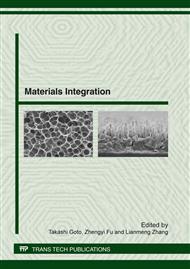p.152
p.161
p.166
p.172
p.178
p.185
p.189
p.193
p.199
Study on Microstructure and Property of Diffusion-Bonded Mo-Cu Joints
Abstract:
Mo and Cu Were Bonded Successfully by Means of Vacuum Diffusion Bonding. The Interfacial Structure of the Joints Was Studied by Scanning Electron Microscopy (SEM), Electron Probe Microanalysis (EPMA), Energy Dispersive X-Ray Spectrometer (EDS) and X-Ray Diffraction (XRD), the Mechanical Property Is Tested by Tensile Strength Measurement. The Results Showed that the Differentatoms Diffused to each other in the Bonding Process. A Mo-Cu Solid Solution Was Formed in the Joint and with No Intermetallic Compounds. The Tensile Strength of the Joint Increased with the Increasing of Temperature, however, while the Holding Time Increased, the Strength Increased in the First Stages and then Decreases. It Were Observed that the Fracture Mode of the Joints Was a Brittle Fracture.
Info:
Periodical:
Pages:
178-182
Citation:
Online since:
March 2012
Authors:
Keywords:
Price:
Сopyright:
© 2012 Trans Tech Publications Ltd. All Rights Reserved
Share:
Citation:


